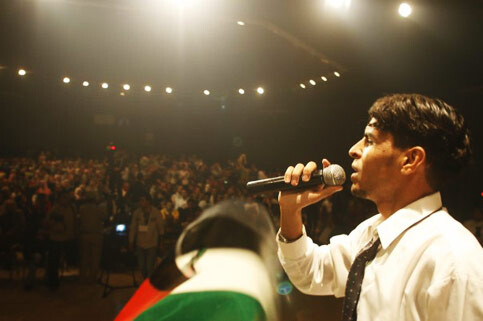The Electronic Intifada 8 December 2008

A Palestinian singer performs at the Gaza Concert.
On 27 October, a group of young Palestinians, none of them over the age of 25, organized the first music concert of its kind in the Gaza Strip, called Gaza Concert ‘08. Regardless of the awful conditions in the Gaza Strip brought on by the 19-month Israeli siege, the youth sang for freedom, peace and ending the unjust siege. Thousands of people came from all over Gaza while several international and local media outlets covered the event that was sponsored by Action for Peace Italia. A mixture of traditional Palestinian debka dance, rap, and nationalist anthems were performed calling for lifting the siege and ending Israeli occupation.
Ahmed, one of the dabka dance performers, lost his hand in an Israeli military operation in 2006 in the Jabaliya refugee camp when he and his friends were hit by Israeli shelling. “I came here to express my readiness and willingness for peace. I lost my hand but I want a just peace with Israelis if they give me my full rights.”
Hatem Shurab, a 24-year-old singer based in Gaza and one of the concert organizers, is a another victim of Israeli siege. He is involved in a journalism training program in the US. However, due to the closure, Shurab was trapped in Gaza and missed his chance along with some friends who were also supposed to participate. He explained, “I came here to sing for peace and freedom. I came here to make the suffering of people heard through songs and music. I sang for Sarah who was sick and unable to get treatment due to the siege. The words of my song say: ‘A girl called Sarah, innocence in her eyes, because of no medications she is about to die. Don’t let Sarah feel the pain, let her fly like a bird in the sky, take the siege away.’”
According to the International Palestinian Campaign to End the Siege on Gaza, this concert was intended to convey the message of a people whose voice is not heard. Nadine Rajab, a coordinator of the campaign, said the concert was to include musicians from Gaza, the West Bank and inside Israel. Because of the siege it was limited to Gaza. Because Israel does not issue permits for Palestinians outside of Gaza to enter the besieged territory, musicians in the West Bank and Israel were featured on pre-recorded video.
Rajab stated, “The occupation banned us from having our brothers from the West Bank. We overcame this as they have sent us a video of their songs. Next year we want to make it regional so our voice would be heard widely. All in one, we have succeeded to achieve our aim of telling our story. Many people think we are savage and terrorists but today’s concert would prove the opposite. Many people abroad are fed up of our news but through this way they will know what’s happening.”
Conditions in the Gaza Strip, already extremely difficult because of the siege, have worsened over the past month. Patients are denied the ability to travel abroad for treatment. And basic commodities like flour, sugar and rice have nearly vanished. Yet Gaza Concert ‘08 is further proof that Palestinians are stronger than siege and occupation. The concert reflects the paradoxical images of sadness, joy, life and death that are found in Gaza on a daily basis. While Israelis may have succeeded in shutting Gaza’s borders to the outside world, they have failed to silence the sounds, hymns and music of young Gazans.
All images credited to the Gaza Concert ‘08.
Sameh A. Habeeb is a photojournalist, humanitarian and peace
activist based in Gaza, Palestine. He writes for several news websites on a freelance basis.
Related Links





